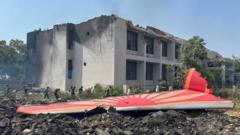In a revealing interview, David Lochridge, a whistleblower and former director of marine operations at Oceangate, shares haunting insights into the safety failures and management decisions that culminated in the tragic Titan submersible incident of June 2023, which took the lives of five individuals, including CEO Stockton Rush.
Titan Whistleblower Speaks Out: A Cautionary Tale of Safety Oversights

Titan Whistleblower Speaks Out: A Cautionary Tale of Safety Oversights
A former Oceangate employee reveals grave safety concerns leading to the Titan submersible tragedy.
Lochridge’s warnings about the design flaws of the Titan went unheard, leading to catastrophic consequences, and he advocates for greater accountability from safety authorities.
The Titan submersible disaster in June 2023 has become a stark illustration of the consequences of ignored safety concerns. David Lochridge, a whistleblower who previously served as Oceangate’s director of marine operations, has come forward detailing systemic failures that he claims contributed to the tragedy. His efforts to flag critical safety issues with the Titan's design and operation were met with resistance, culminating in his dismissal in 2018 for voicing his concerns, which he believes highlights a larger issue of insufficient regulatory oversight.
Lochridge, who has over 25 years of experience in marine operations, first joined Oceangate in 2011 with high hopes of contributing to the ambitious expedition plans involving the Titanic wreck. However, he quickly became troubled by the company's decision to move the design and engineering work in-house, previously carried out by an independent lab, which raised red flags for him. Despite his background and expertise, his warnings were largely ignored as the company raced to make the Titan ready for tourists.
The carbon fibre hull, which Lochridge scrutinized for its integrity, was reportedly flawed and untested for providing the necessary safety assurances at extreme depths. After outlining numerous concerns to CEO Stockton Rush and other executives, Lochridge found himself isolated as organizational pressure mounted against his stance on safety.
He noted significant discrepancies, including delamination of the carbon fibre layers and incorrectly machined titanium domes, all of which contributed to his insistence that the Titan should undergo rigorous independent certification—a request ultimately denied. Fueled by a sense of duty for passenger safety, Lochridge took his grievances to OSHA, but the response from regulatory authorities fell short of his expectations.
The slow response from OSHA culminated in a tragic outcome when Titan imploded, claiming five lives during its dive to the Titanic wreck. In the aftermath, a US Coast Guard report confirmed Lochridge’s assessments of major failures involving Oceangate's production processes and stated that better communication between agencies may have averted the disaster. Lochridge, echoing the report’s findings, believes appropriate and prompt intervention could have prevented the tragedy that ultimately unfolded.
Oceangate has since ceased operations but faces ongoing scrutiny over past decisions and their implications for management protocols and safety accountability within the deep-sea expedition field. The chilling story serves as not only a personal recount but a cautionary tale, urging a re-evaluation of safety practices in industries where the stakes are life and death.
The Titan submersible disaster in June 2023 has become a stark illustration of the consequences of ignored safety concerns. David Lochridge, a whistleblower who previously served as Oceangate’s director of marine operations, has come forward detailing systemic failures that he claims contributed to the tragedy. His efforts to flag critical safety issues with the Titan's design and operation were met with resistance, culminating in his dismissal in 2018 for voicing his concerns, which he believes highlights a larger issue of insufficient regulatory oversight.
Lochridge, who has over 25 years of experience in marine operations, first joined Oceangate in 2011 with high hopes of contributing to the ambitious expedition plans involving the Titanic wreck. However, he quickly became troubled by the company's decision to move the design and engineering work in-house, previously carried out by an independent lab, which raised red flags for him. Despite his background and expertise, his warnings were largely ignored as the company raced to make the Titan ready for tourists.
The carbon fibre hull, which Lochridge scrutinized for its integrity, was reportedly flawed and untested for providing the necessary safety assurances at extreme depths. After outlining numerous concerns to CEO Stockton Rush and other executives, Lochridge found himself isolated as organizational pressure mounted against his stance on safety.
He noted significant discrepancies, including delamination of the carbon fibre layers and incorrectly machined titanium domes, all of which contributed to his insistence that the Titan should undergo rigorous independent certification—a request ultimately denied. Fueled by a sense of duty for passenger safety, Lochridge took his grievances to OSHA, but the response from regulatory authorities fell short of his expectations.
The slow response from OSHA culminated in a tragic outcome when Titan imploded, claiming five lives during its dive to the Titanic wreck. In the aftermath, a US Coast Guard report confirmed Lochridge’s assessments of major failures involving Oceangate's production processes and stated that better communication between agencies may have averted the disaster. Lochridge, echoing the report’s findings, believes appropriate and prompt intervention could have prevented the tragedy that ultimately unfolded.
Oceangate has since ceased operations but faces ongoing scrutiny over past decisions and their implications for management protocols and safety accountability within the deep-sea expedition field. The chilling story serves as not only a personal recount but a cautionary tale, urging a re-evaluation of safety practices in industries where the stakes are life and death.




















